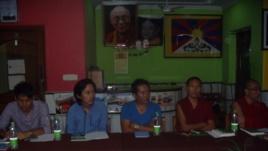
Participants at the Middle Way Approach workshop held in New Delhi, July 13 2013.
Photo: voatibetanenglish.com
A two-day workshop on “The Middle Way Approach” was held in Samyeling Tibetan Colony, New Delhi by the Central Tibetan Administration (CTA) on July 13-14, 2013.
The workshop was attended by 22 young representatives from India, Nepal and Bhutan to assess the viability of the Middle Way Approach, especially in the Tibetan provinces of U-tsang, Amdo and Kham, within the framework of the People’s Republic of China.
Just a few days earlier, on July 11, Sikyong Dr Lobsang Sangay, addressing the Tibetan community in Mussoorie, Uttarakhand, stressed the commitment of the CTA in using the Middle Way Approach in dialogues with China. He said that this policy, initiated by His Holiness the Dalai Lama, is finding acceptance amongst prominent Tibetans in Tibet and amongst Chinese intellectuals as well, including the imprisoned Nobel Laureate Liu Xiaobo. He also said that this policy has enabled several governments to raise the issue of Tibet in their bilateral talks with China, including the Obama government. Furthermore, he stated that it has established a series of talks between Chinese representatives and the envoys of HH Dalai Lama, and has facilitated the passage of several students and monastics to India.
In May this year, Dr Sangay’s statements on the Middle Way Policy in the Council of Foreign Relations in the United States led to unrest in several quarters. His statements went against the spirit of the Dalai Lama’s Strasbourg Proposal in 1988, which called for genuine democracy within Tibet and self-determination. In his speech Dr Sangay stated that autonomy within Tibet would be for a limited duration only, that democracy within Tibet was out, and that Communist Party rule was acceptable, and that China would have control over military deployment in Tibet. It would appear that in view of previous failures Dr Sangay is attempting a realistic approach in dialogues with China, but it remains to be seen whether such a compromise will find acceptance in the Tibetan community.




 Print
Print Email
Email